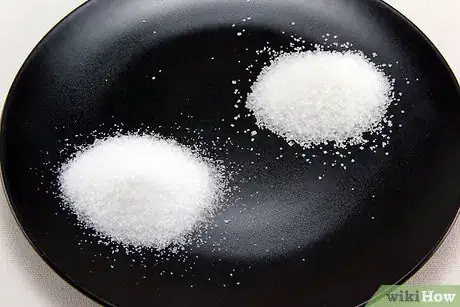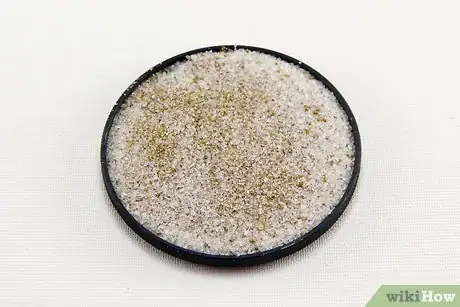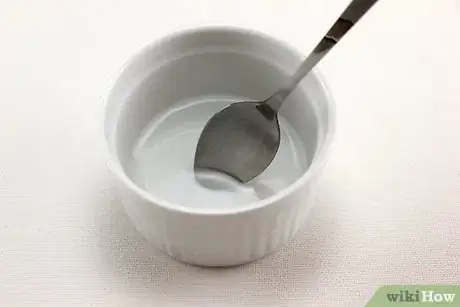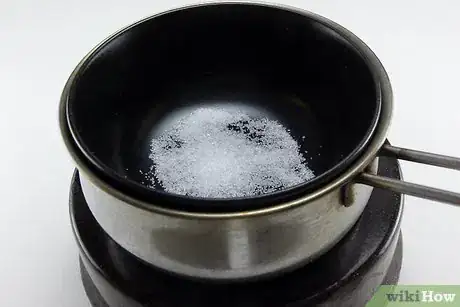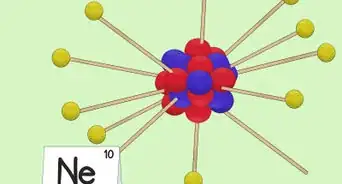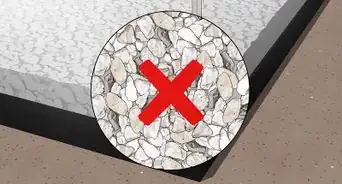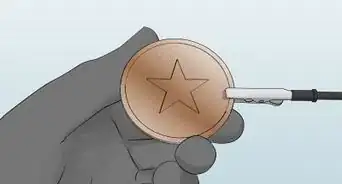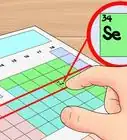This article was co-authored by Meredith Juncker, PhD. Meredith Juncker is a PhD candidate in Biochemistry and Molecular Biology at Louisiana State University Health Sciences Center. Her studies are focused on proteins and neurodegenerative diseases.
There are 9 references cited in this article, which can be found at the bottom of the page.
This article has been viewed 139,693 times.
If you accidentally add salt to your sugar bowl or sugar to your salt shaker, your best option is to pitch the mixture and start fresh. If, however, you are interested in separating salt and sugar as a scientific experiment, there are ways to accomplish the task. To be clear, though, of the two methods described here, one is simple and safe but arduous and never completely successful, while the other is a chemistry experiment that can be extremely dangerous without proper precautions, know-how, and supervision. Do not attempt the second method unless you are well-versed in safety protocols and have the proper supervision and/or instruction.
Steps
Attempting Mechanical Separation
-
1Assess the different grain sizes of salt and sugar. At first glance, table salt and granulated sugar look very similar, including in size. The minute differences in the average grain sizes of the two, however, does provide an option for attempting separation.
- Regular table salt has an average grain size of 100 microns, or 0.1 mm.[1] Note that other types of household salt, such as kosher or pickling salt, will have widely divergent average grain sizes.
- Regular granulated sugar has an average grain size of 500 microns (0.5 mm), or five times larger than table salt.[2] Again, other sugars, like powdered or brown sugar, will have very different average sizes.
-
2Acquire a sieve that is sized in between these grain sizes. Laboratory-style sieves (or strainers) are sized according to the spaces between the mesh. You want to find one that is large enough to let the salt through, but small enough to stop the sugar.
- Since salt is 100 microns across and sugar is 500, a 250 micron (0.25 mm) sieve would make a good in-between choice.[3]
Advertisement -
3Get shaking. This method is a simple as it seems. Add small amounts of the salt-sugar mixture at a time to the sieve (with a bowl underneath), and shake, shimmy, and rattle it to slowly but surely send much of the salt through the mesh openings and into the bowl.[4]
- Because this method relies on the difference in average grain sizes, it is never going to be entirely successful, There will be some smaller sugar grains that slip through and some larger salt grains that stay put, not to mention those that might stick together — at least until the point when you’re tired of sifting.
- Despite its limitations, however, sieving is a legitimate scientific means of separation.[5] Just don’t expect to use the separated sugar in your coffee, unless you like a salty kick!
Dissolving and Evaporating the Mixture
-
1Consider a simpler, safer alternative for a science experiment. If you are teaching or learning about separating materials and/or making solutions, think about using salt and sand as your mixed materials instead of salt and sugar. It is a bit easier, much safer, and equally interesting.
- Separating salt and sand involves adding warm water to the combination in order to dissolve the salt, straining out the sand by pouring the water mix through a fine sieve, then carefully boiling the water to leave the salt behind. It does not involve flammable liquids or potentially dangerous fumes.[6]
- The safety issue is likely the main reason why it is hard to find lesson plans or legitimate scientific advice about how to separate salt and sugar. If you insist upon doing so, however, take every precaution. Do not try it at home unless you are well-versed in chemistry and have observed all safety measures.
- First and foremost, always have a working fire extinguisher nearby.
-
2Add ethanol to your salt and sugar mixture. The larger the amount of salt and sugar, the more ethanol you will need to use. There must be enough alcohol that the sugar dissolves without being oversaturated.[7]
- If at all possible, consider using only a small amount of salt and sugar or doing your separation in batches if you have a large amount. Ethanol is flammable and using too much will increase your fire risk.
-
3Mix the solution with a spoon or a stir stick to dissolve the sugar. Once the mixture settles, the salt should be sitting at the bottom of the beaker.
- Granulated sugar is a substance containing carbon molecules that is soluble in alcohol and other organic solvents (such as acetone, for example). Table salt, however, is far less soluble in alcohol than it is in water because the former’s lesser polarity provides less attraction to salt’s sodium and chlorine ions.[8] [9]
-
4Pour the alcohol solution through a very fine strainer, and into the new container. Your strainer should have gathered all the salt particles. Let the strainer dry and then pour the salt into a separate container.
- Remember that table salt has an average grain size of 100 microns, so you will need a strainer with smaller mesh openings than that.[10] You may want to instead use a coffee filter placed inside the sieve.
-
5Wait for the alcohol to evaporate, or create a steam bath. To make a steam bath, place a small saucepan filled one-quarter full with water on your heating element. Make sure you can set a glass bowl directly on top of the saucepan so that the bottom of the bowl does not contact the water in the saucepan.
- A steam bath is similar to a double boiler used in cooking.[11]
-
6Place the sugar and ethanol mixture in the open bowl on top of the steam bath. Turn on a fan or a hood and wear a mask to avoid breathing in the alcohol fumes.[12]
- Only after placing the alcohol solution in the top bowl, heat up the water to a low boil on medium heat. The steam bath is designed to gently heat the solution because of the alcohol’s volatility. Other methods can cause a spark and light the alcohol.
- Do not let the alcohol solution come in contact with the heating element or any open flame.
- Stay away from the steam forming at the top of your open container of sugar and alcohol while it distills.
-
7Continue the process until all the alcohol has evaporated. The sugar will be left in the open dish. Pour the sugar into a separate container.[13]
- Exercise caution until and even beyond the conclusion of the experiment. Any remaining alcohol residue could be ignited by the still-hot heating element.
Expert Q&A
Did you know you can get expert answers for this article?
Unlock expert answers by supporting wikiHow
-
QuestionWhat is the simplest method for separating salt and sugar?
 Meredith Juncker, PhDMeredith Juncker is a PhD candidate in Biochemistry and Molecular Biology at Louisiana State University Health Sciences Center. Her studies are focused on proteins and neurodegenerative diseases.
Meredith Juncker, PhDMeredith Juncker is a PhD candidate in Biochemistry and Molecular Biology at Louisiana State University Health Sciences Center. Her studies are focused on proteins and neurodegenerative diseases.
Scientific Researcher
-
QuestionHow can I separate mixtures without using strainers or handpicking?
 Meredith Juncker, PhDMeredith Juncker is a PhD candidate in Biochemistry and Molecular Biology at Louisiana State University Health Sciences Center. Her studies are focused on proteins and neurodegenerative diseases.
Meredith Juncker, PhDMeredith Juncker is a PhD candidate in Biochemistry and Molecular Biology at Louisiana State University Health Sciences Center. Her studies are focused on proteins and neurodegenerative diseases.
Scientific Researcher There are many ways you can separate mixtures without using a strainer or handpicking technique. Choosing the correct method of separation depends on the nature of the mixture you're trying to separate. 1) Decantation separates immiscible liquids based on different densities. 2) Chromatography can also be used to separate different types of mixtures. However, this method requires laboratory expertise and equipment. 3) Distillation separates liquids by exploiting differences in boiling points (i.e. selective boiling and condensation).
There are many ways you can separate mixtures without using a strainer or handpicking technique. Choosing the correct method of separation depends on the nature of the mixture you're trying to separate. 1) Decantation separates immiscible liquids based on different densities. 2) Chromatography can also be used to separate different types of mixtures. However, this method requires laboratory expertise and equipment. 3) Distillation separates liquids by exploiting differences in boiling points (i.e. selective boiling and condensation). -
QuestionHow would I separate sand and sugar?
 Community AnswerSince sand is insoluble and sugar is soluble, pour water into the mixture and pour the mixture into a strainer. The sand should be left behind. The water in the sugar solution should be evaporated too, so the sugar should be left behind.
Community AnswerSince sand is insoluble and sugar is soluble, pour water into the mixture and pour the mixture into a strainer. The sand should be left behind. The water in the sugar solution should be evaporated too, so the sugar should be left behind.
Warnings
- Once separated, the sugar and salt may not be consumable. Avoid ingesting it.⧼thumbs_response⧽
Things You'll Need
- Salt/sugar solution
- Ethanol
- Glass beakers/liquid measuring cups
- Small saucepan
- Heat source
- Strainer
- Small containers
- Fire extinguisher
- Fan/ventilation hood
- Spoon
References
- ↑ http://burningissues.org/car-www/science/particle-size.htm
- ↑ http://www.chefsteps.com/ingredients/sugar
- ↑ https://www.sympatec.com/en/applications/sugar/
- ↑ https://www.reddit.com/r/askscience/comments/2yvd27/is_there_a_way_to_separate_white_sugar_and_table/
- ↑ http://scienceweb.asta.edu.au/verve/_resources/asta_5-1-1_bi_mixing_yr7_v1_2.pdf
- ↑ http://www.scientificamerican.com/article/bring-science-home-separate-solutions/
- ↑ https://www.enotes.com/homework-help/how-could-seperat-amixture-salt-sugger-88767
- ↑ https://www.enotes.com/homework-help/how-could-seperat-amixture-salt-sugger-88767
- ↑ http://www.middleschoolchemistry.com/lessonplans/chapter5/lesson3
